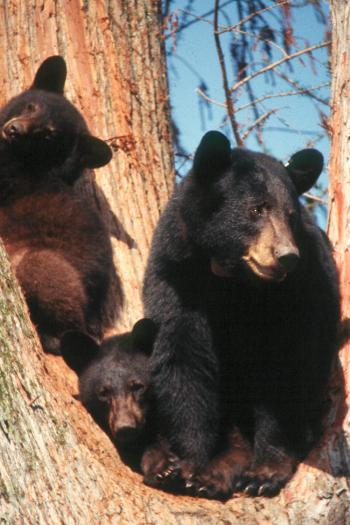
Snares capture bears
NEW ORLEANS (AP) — Snares for hogs or coyotes caught five Louisiana black bears — three of them cubs — since October, according to the state Department of Wildlife and Fisheries.
All survived, though one cub was later killed by a car and two adults seen dragging a snare will probably lose part of a leg, said Maria Davidson, the department’s large carnivore biologist.
“A snare’s indiscriminate. They’ll catch whatever comes around,” Davidson said Tuesday. So are bears, omnivores that will go after almost any bait.
A snare is generally a loop of thin cable suspended over a trail so an animal will put its head through it. Like plastic ties used for computer wiring, they have locks that tighten with each pull.
“It typically chokes the animal down and kills it,” Davidson said.
Davidson said snares are popular because they’re cheap and simple. About 10,000 were sold in 2011 around Louisiana, according to testimony before the state Wildlife and Fisheries Commission.
The department tried unsuccessfully last year to require that snares in 15 parishes with significant numbers of bears include modifications to let bears escape — “relaxing locks” that release pressure if an animal stops pulling, and breakaway devices that could let a bear pull free.
The department is asking trappers in those 15 parishes to use other kinds of traps: foot-hold traps for coyotes and, for hogs, cage or corral traps with top openings that bears can climb out of. Those recommendations are in a brochure written by the department and the Louisiana Trappers & Alligator Hunters Association, which opposed the restrictions tabled last year by the commission.
“Once you start the restrictions, they never are lifted,” said president Tony Howard of Sarepta. “And they will just go to statewide. Because the bears are going to be statewide. ... Pretty much anywhere is bear territory.”
A total of 12 bears have been snared since 2010. Three died — two of them in spite of relaxing locks, according to a list sent by Davidson.
In St. Mary Parish, Catherine Siracusa, black bear conflict officer, said trappers and hunters are aware of the plight of Louisiana black bears so few incidents occur.
Most traps in this area, usually set for hogs, have escape routes in the top of the traps, she said.
Louisiana black bears, one of 16 subspecies of American black bears, have been listed as threatened since 1992, when the population was estimated at 300. The latest estimate of 500 did not include an area where 49 females and their 100 or so cubs were moved in the mid-2000s. That will be among areas the department, which hopes to get the animal off the federal list and allow a regulated hunting season, wants to study this coming summer, Davidson said.
The department also needs to show it is dealing with human threats such as poaching, road-kill and capture in snares meant for other animals.
It’s not easy to cut down road-kill, Davidson said. “But we have purchased a lot of billboards in areas where we see high road-kill, to warn motorists to slow down and be watchful.”
Trappers who accidentally snare bears are supposed to notify the department so a biologist can come out, tranquilize the bear and free it. That doesn’t always happen. One hunter reported seeing one bear dragging a snare cable on its foot in Pointe Coupee Parish in October and a smaller bear dragging one on Dec. 22, Davidson said.
Tranquilizer darts are needed for the 50- to 80-pound cubs as well as adults, Davidson said.
“What happens with cubs — they don’t seem to pull as hard. So they don’t get choked down quite as quickly,” she said. “If we can get to them relatively quickly we can cut them out.”
The cutting free is quick, too: “They’re bawling at the top of their lungs and Mama’s not happy. We dart the cubs, get the snare off and back off.”
- Log in to post comments
